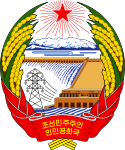
Back التوحيد الكوري Arabic Обединение на Корея Bulgarian কোরীয় পুনর্মিলন Bengali/Bangla Reunificació coreana Catalan Koreanische Wiedervereinigung German Ενοποίηση της Κορέας Greek Reunificación de Corea Spanish اتحاد کره Persian Réunification de la Corée French איחוד קוריאה HE
| Korean reunification | |
 | |
| Korean name | |
|---|---|
| Hangul | 남북통일 |
| Hanja | |
| Revised Romanization | Nambuk Tong(-)il |
| McCune–Reischauer | Nampuk T'ongil |
 |
|---|
|
|
 |
|---|
|
|
Korean reunification is the aspired unification of North Korea and South Korea into a singular Korean sovereign state. The process towards reunification of the peninsula while still maintaining two opposing regimes was started by the June 15th North–South Joint Declaration in June 2000, was reaffirmed by the October 4th Declaration in October 2007 and the Panmunjom Declaration in April 2018, and the joint statement of United States President Donald Trump and North Korean leader Kim Jong Un at the Singapore Summit in June 2018. In the Panmunjom Declaration, the two countries agreed to work to officially end the Korean conflict in the future.
Prior to the First World War and Korea under Japanese rule (1910–1945), all of Korea had been unified as a single state for centuries, notably under the Goryeo and Joseon dynasties (the latter of which was declared the Korean Empire in 1897). After the end of World War II in 1945 and during the beginning of the Cold War, Korea had a unified government, the People's Republic of Korea. However, this would be brief and serve as the last government, as Korea was divided into two countries along the 38th parallel (now the Korean Demilitarized Zone) in 1948. After World War II, North Korea was occupied by the Soviet Union, and later administered by the Workers' Party of Korea under Kim Il Sung. South Korea was occupied by the United States, later becoming independent under Syngman Rhee. Both governments of the two new Korean states claimed to be the sole legitimate government of all of Korea. The Korean War, which began in June 1950, ended in a stalemate in July 1953.
Even after the end of the Korean War, reunification proved a challenge as the two countries increasingly diverged at a steady pace. The relations between North and South Korea warmed somewhat in early 2000s and again in late 2010s when South Korea pursued the Sunshine Policy of greater engagement with the North, though relations have subsequently deteriorated.[1][2][3] Further deterioration has also been seen in 2024, with Kim Jong Un officially "ruling out unification" with South Korea, and subsequently demolishing the Arch of Reunification in Pyongyang.[4][5]
- ^ Miller, J Berkshire (May 4, 2018). "Great aspirations: Inter-Korea relations going forward". Al Jazeera. Retrieved January 24, 2024.
- ^ Ryall, Julian (February 19, 2018). "Majority of South Koreans favor North Korea 'friendship'". DW.COM. Retrieved January 24, 2024.
- ^ Taylor, Adam (27 April 2018). "The full text of North and South Korea's agreement, annotated". The Washington Post. Retrieved January 24, 2024.
- ^ "North Korea Demolishes Monument Symbolising Union With South: Report". NDTV.com. Retrieved 2024-01-23.
- ^ Mao, Frances (2024-01-23). "Kim Jong Un: Is North Korea's leader actually considering war?". BBC News. Retrieved 2024-01-23.
© MMXXIII Rich X Search. We shall prevail. All rights reserved. Rich X Search